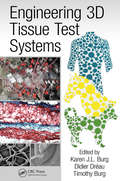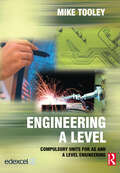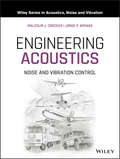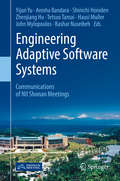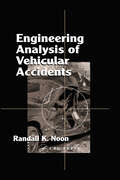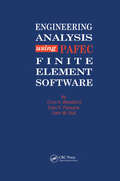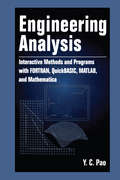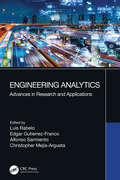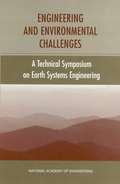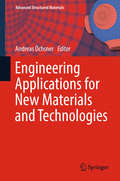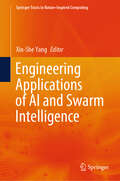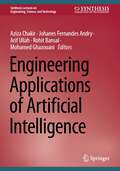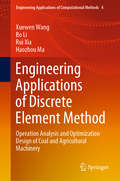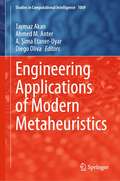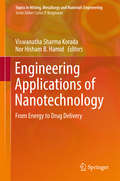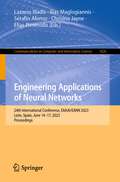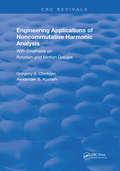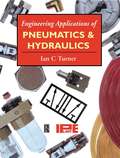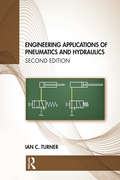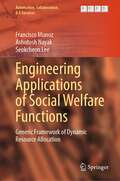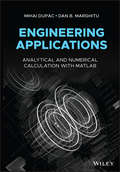- Table View
- List View
Engineering 3D Tissue Test Systems
by Karen J. L. Burg, Didier Dréau and Timothy BurgEngineering 3D Tissue Test Systems provides an introduction to, and unique coverage of, a rapidly evolving area in biomaterials engineering. It reveals the current and future research responses, the current and future diagnostic applications, and provides a comprehensive overview to foster innovation. It offers insight into the importance of 3D systems and their use as benchtop models, spanning applications from basic scientific research to clinical diagnostics. Methods and limitations of building 3D tissue structures are evaluated, with attention given to the cellular, polymeric, and fabrication instrumentation components. The book covers the important aspects of polymeric tissue test systems, highlighting the needs and constraints of the industry, and includes a chapter on regulatory and pricing issues.
Engineering A Level
by Mike TooleyEngineering A Level covers each of the compulsory AS and A2 units from Edexcel in a dedicated chapter. Full coverage is given to the three units required at AS Level, and the 3 additional A2 units required for completion of the A Level award.Students following the GCE courses will find this book essential reading, as it covers all the material they will be following through the duration of their study. Knowledge-check questions and activities are included throughout, along with learning summaries, innovative ‘Another View’ features, and applied maths integrated alongside the appropriate areas of engineering study. All examples relate directly (and exclusively) to engineering practice, to emphasise application of theory in real-world engineering contexts.The result is a clear, straightforward and easily accessible text. The book offers a valuable insight into various areas of engineering technology and related industries, providing a potential springboard to further training, eventual progression to qualifications within higher education, or to suitable employment within the engineering sector.A companion website offers a variety of student resources providing practical assignments to supplement the material in the textbook, including using CAD / CAM, computer modelling (using spreadsheets), and Visio templates, shapes and symbols available for download.Mike Tooley is formerly Director of Learning at Brooklands College, Surrey, and is the author of many best-selling engineering and electronics books.
Engineering Acoustics: Noise and Vibration Control (Wiley Series in Acoustics Noise and Vibration)
by Malcolm J. Crocker Jorge P. ArenasA comprehensive evaluation of the basic theory for acoustics, noise and vibration control together with fundamentals of how this theoretical material can be applied to real world problems in the control of noise and vibration in aircraft, appliances, buildings, industry, and vehicles. The basic theory is presented in elementary form and only of sufficient complication necessary to solve real practical problems. Unnecessary advanced theoretical approaches are not included. In addition to the fundamental material discussed, chapters are included on human hearing and response to noise and vibration, acoustics and vibration transducers, instrumentation, noise and vibration measurements, and practical discussions concerning: community noise and vibration, interior and exterior noise of aircraft, road and rail vehicles, machinery noise and vibration sources, noise and vibration in rapid transit rail vehicles, automobiles, trucks, off road vehicles, and ships. In addition, extensive up to date useful references are included at the end of each chapter for further reading. The book concludes with a glossary on acoustics, noise and vibration
Engineering Adaptive Software Systems: Communications Of NII Shonan Meetings (Lecture Notes In Computer Science / Programming And Software Engineering Ser. #7475)
by John Mylopoulos Yijun Yu Arosha Bandara Shinichi Honiden Zhenjiang Hu Tetsuo Tamai Hausi Muller Bashar NuseibehThis book discusses the problems and challenges in the interdisciplinary research field of self-adaptive software systems. Modern society is increasingly filled with software-intensive systems, which are required to operate in more and more dynamic and uncertain environments. These systems must monitor and control their environment while adapting to meet the requirements at runtime. This book provides promising approaches and research methods in software engineering, system engineering, and related fields to address the challenges in engineering the next-generation adaptive software systems. The contents of the book range from design and engineering principles (Chap. 1) to control–theoretic solutions (Chap. 2) and bidirectional transformations (Chap. 3), which can be seen as promising ways to implement the functional requirements of self-adaptive systems. Important quality requirements are also dealt with by these approaches: parallel adaptation for performance (Chap. 4), self-adaptive authorization infrastructure for security (Chap. 5), and self-adaptive risk assessment for self-protection (Chap. 6). Finally, Chap. 7 provides a concrete self-adaptive robotics operating system as a testbed for self-adaptive systems. The book grew out of a series of the Shonan Meetings on this ambitious topic held in 2012, 2013, and 2015. The authors were active participants in the meetings and have brought in interesting points of view. After several years of reflection, they now have been able to crystalize the ideas contained herein and collaboratively pave the way for solving some aspects of the research problems. As a result, the book stands as a milestone to initiate further progress in this promising interdisciplinary research field.
Engineering Analysis of Flight Vehicles (Dover Books on Aeronautical Engineering)
by Holt Ashley"Written by one of the leading aerospace educators of our time, each sentence is packed with information. An outstanding book." -- Private Pilot"Illuminated throughout by new twists in explaining familiar concepts, helpful examples and intriguing 'by-the-ways.' A fine book." -- Canadian Aeronautics and Space JournalThis classic by a Stanford University educator and a pioneer of aerospace engineering introduces the complex process of designing atmospheric flight vehicles. An exploration of virtually every important subject in the fields of subsonic, transonic, supersonic, and hypersonic aerodynamics and dynamics, the text demonstrates how these topics interface and how they complement one another in atmospheric flight vehicle design. The mathematically rigorous treatment is geared toward graduate-level students, and it also serves as an excellent reference. Problems at the end of each chapter encourage further investigation of the text's material, the study of fresh ideas, and the exploration of new areas.
Engineering Analysis of Vehicular Accidents
by Randall K. NoonAccident analysis is not like a classroom problem where the equations are selected and solved, and the matter is considered closed. In this line of forensics, engineering skill must be combined with skillful practice for the successful presentation of evidence to a jury. In this book, the author demonstrates the application of engineering skills, methods, and judgment for analyzing vehicular accidents. A definition of vehicular accident reconstruction and its role in the legal system is provided. General accident statistics are cited, and some general strategies for accident reconstruction are given, along with many examples and case studies. The author includes novel and unusual treatment of the momentum method and coefficient of restitution (which is not yet widespread in accident analysis) and shows how to select the best methods of analysis in a given accident reconstruction.
Engineering Analysis using PAFEC Finite Element Software
by C H WoodfordThe aim of this book is to provide professional engineers and students of engineering with a sound working knowledge of the finite element method for engineering analysis and engineering design. This readable text will serve as a guide both to the method, and to its implementation in PAFEC (Program for Automatic Finite Element Calculations) softwar
Engineering Analysis: Interactive Methods and Programs with FORTRAN, QuickBASIC, MATLAB, and Mathematica (Allyn And Bacon Series In Mechanical Engineering)
by Yen-Ching PaoThis book provides a concise introduction to numerical concepts in engineering analysis, using FORTRAN, QuickBASIC, MATLAB, and Mathematica to illustrate the examples. Discussions include:matrix algebra and analysissolution of matrix equationsmethods of curve fitmethods for finding the roots of polynom
Engineering Analytics: Advances in Research and Applications
by Luis RabeloEngineering analytics is becoming a necessary skill for every engineer. Areas such as Operations Research, Simulation, and Machine Learning can be totally transformed through massive volumes of data. This book is intended to be an introduction to Engineering Analytics that can be used to improve performance tracking, customer segmentation for resource optimization, patterns and classification strategies, and logistics control towers. Basic methods in the areas of visual, descriptive, predictive, and prescriptive analytics and Big Data are introduced. Industrial case studies and example problem demonstrations are used throughout the book to reinforce the concepts and applications. The book goes on to cover visual analytics and its relationships, simulation from the respective dimensions and Machine Learning and Artificial Intelligence from different paradigms viewpoints. The book is intended for professionals wanting to work on analytical problems, for Engineering students, Researchers, Chief-Technology Officers, and Directors that work within the areas and fields of Industrial Engineering, Computer Science, Statistics, Electrical Engineering Operations Research, and Big Data.
Engineering And Environmental Challenges: Technical Symposium On Earth Systems Engineering
by National Academy of Engineering Staff National Academy of Engineering Annual Meeting StaffDealing with the challenges presented by climate change or rapid urban development require cooperation and expertise from engineering, social and natural sciences. Earth systems engineering is an emerging area of multidisclinary study that takes a holistic view of natural and human system interactions to better understand complex systems. It seeks to develop methods and tools that enable technically sound and ethically wise decisions. Engineering and Environmental Challenges presents the proceedings of a National Academy of Engineering public symposium on Earth systems engineering.
Engineering And Technology Education: Learning By Design
by Michael Hacker David BurghardtEngineering and Technology Education: Learning by Design.
Engineering And Technology Education: Learning By Design
by Michael Hacker David BurghardtEngineering AND Technology Education Learning by Design
Engineering Applications for New Materials and Technologies (Advanced Structured Materials #85)
by Andreas ÖchsnerThis book discusses the expertise, skills, and techniques needed for the development of new materials and technologies. It focuses on finite element and finite volume methods that are used for engineering simulations, and present many state-of-the-art applications and advances to highlight these methods’ importance. For example, modern joining technologies can be used to fabricate new compound or composite materials, even those formed from dissimilar component materials. These composite materials are often exposed to harsh environments, must deliver specific characteristics, and are primarily used in automotive and marine technologies, i.e., ships, amphibious vehicles, docks, offshore structures, and even robots. To achieve the desired material performance, computer-based engineering tools are widely used for simulation, data evaluation, and design processes.
Engineering Applications of AI and Swarm Intelligence (Springer Tracts in Nature-Inspired Computing)
by Xin-She YangThe book is focused on latest developments and findings on engineering applications of AI and swarm intelligence. It provides comprehensive reviews and surveys on implementations and coding aspects of case studies and applications where appropriate. The book is useful for scholars, lecturers, and practitioners from academia and industrial applications. The readership of this book also includes Ph.D. students and researchers with a wide experience in the subject areas.
Engineering Applications of Artificial Intelligence (Synthesis Lectures on Engineering, Science, and Technology)
by Rohit Bansal Aziza Chakir Johanes Fernandes Andry Arif Ullah Mohamed GhazouaniMaking intelligent devices and systems is the science and engineering of artificial intelligence (AI). In order to solve many of the most difficult problems in computer science, this important multidisciplinary discipline plays a crucial role in the field of technology nowadays. The book also addresses the topic of machine learning because it is closely related to AI. By no means is the list of subjects below intended to be comprehensive. The main objective of this book is to provide researchers, scientists, business professionals, and academics insight into original theories and research findings on the use of human cognitive models in diverse real-world computing applications. Through this book, the authors built an interdisciplinary forum where researchers from many fields may share their work and explore how to engineer human brain processes, learning mechanisms, and decision-making processes.
Engineering Applications of Discrete Element Method: Operation Analysis and Optimization Design of Coal and Agricultural Machinery (Engineering Applications of Computational Methods #4)
by Bo Li Xuewen Wang Rui Xia Haozhou MaThis book introduces the engineering application of the discrete element method (DEM), especially the simulation analysis of the typical equipment (scraper conveyor, coal silos, subsoiler) in the coal and agricultural machinery. In this book, the DEM is applied to build rigid and loose coupling model, and the kinematic effect of the bulk materials, the mechanical effect of the interaction between the bulk materials, and the mechanical equipment in the operation process of the relevant equipment are studied. On this basis, the optimization design strategy of the relevant structure is proposed. This book effectively promotes the application of DEM in engineering, analyzes the operation state, failure mechanism, and operation effect of related equipment in operation, and provides theoretical basis for the optimal design of equipment. The book is intended for undergraduate and graduate students who are interested in mechanical engineering, researchers investigating coal and agricultural machinery, and engineers working on designing related equipments.
Engineering Applications of Modern Metaheuristics (Studies in Computational Intelligence #1069)
by A. Şima Etaner-Uyar Diego Oliva Ahmed M. Anter Taymaz AkanThis book is a collection of various methodologies that make it possible for metaheuristics and hyper-heuristics to solve problems that occur in the real world. This book contains chapters that make use of metaheuristics techniques. The application fields range from image processing to transmission power control, and case studies and literature reviews are included to assist the reader. Furthermore, some chapters present cutting-edge methods for load frequency control and IoT implementations. In this sense, the book offers both theoretical and practical contents in the form of metaheuristic algorithms. The researchers used several stochastic optimization methods in this book, including evolutionary algorithms and Swarm-based algorithms. The chapters were written from a scientific standpoint. As a result, the book is primarily aimed at undergraduate and postgraduate students of Science, Engineering, and Computational Mathematics, but it can also be used in courses on Artificial Intelligence, among other things. Similarly, the material may be beneficial to research in evolutionary computation and artificial intelligence communities.
Engineering Applications of Nanotechnology
by Viswanatha Sharma Korada Nor Hisham B HamidThis book focuses on the use of nanotechnology in several fields of engineering. Among others, the reader will find valuable information as to how nanotechnology can aid in extending the life of component materials exposed to corrosive atmospheres, in thermal fluid energy conversion processes, anti-reflection coatings on photovoltaic cells to yield enhanced output from solar cells, in connection with friction and wear reduction in automobiles, and buoyancy suppression in free convective heat transfer. Moreover, this unique resource presents the latest research on nanoscale transport phenomena and concludes with a look at likely future trends.
Engineering Applications of Neural Networks: 23rd International Conference, EAAAI/EANN 2022, Chersonissos, Crete, Greece, June 17–20, 2022, Proceedings (Communications in Computer and Information Science #1600)
by Elias Pimenidis Chrisina Jayne Lazaros Iliadis Anastasios TefasThis book constitutes the refereed proceedings of the 23rd International Conference on Engineering Applications of Neural Networks, EANN 2022, held in Chersonisos, Crete, Greece, in June 2022.The 37 revised full papers and 5 revised short papers presented were carefully reviewed and selected from 72 submissions. The papers are organized in topical sections on Bio inspired Modeling / Novel Neural Architectures; Classification / Clustering; Machine Learning; Convolutional / Deep Learning; Datamining / Learning / Autoencoders; Deep Learning / Blockchain; Machine Learning for Medical Images / Genome Classification; Reinforcement /Adversarial / Echo State Neural Networks; Robotics / Autonomous Vehicles, Photonic Neural Networks; Text Classification / Natural Language.
Engineering Applications of Neural Networks: 24th International Conference, EAAAI/EANN 2023, León, Spain, June 14–17, 2023, Proceedings (Communications in Computer and Information Science #1826)
by Elias Pimenidis Chrisina Jayne Lazaros Iliadis Ilias Maglogiannis Serafin AlonsoThis book constitutes the refereed proceedings of the 24th International Conference on Engineering Applications of Neural Networks, EANN 2023, held in León, Spain, in June 2023.The 41 revised full papers and 8 revised short papers presented were carefully reviewed and selected from 125 submissions. The papers are organized in topical sections on artificial intelligence - computational methods - ethology; classification - filtering - genetic algorithms; complex dynamic networks' optimization/ graph neural networks; convolutional neural networks/spiking neural networks; deep learning modeling; deep/machine learning in engineering; LEARNING (reinforcemet - federated - adversarial - transfer); natural language - recommendation systems.
Engineering Applications of Noncommutative Harmonic Analysis: With Emphasis on Rotation and Motion Groups (Routledge Revivals)
by Gregory S. Chirikjian Alexander B. KyatkinFirst published in 2001. The classical Fourier transform is one of the most widely used mathematical tools in engineering. However, few engineers know that extensions of harmonic analysis to functions on groups holds great potential for solving problems in robotics, image analysis, mechanics, and other areas. For those that may be aware of its potential value, there is still no place they can turn to for a clear presentation of the background they need to apply the concept to engineering problems.Engineering Applications of Noncommutative Harmonic Analysis brings this powerful tool to the engineering world. Written specifically for engineers and computer scientists, it offers a practical treatment of harmonic analysis in the context of particular Lie groups (rotation and Euclidean motion). It presents only a limited number of proofs, focusing instead on providing a review of the fundamental mathematical results unknown to most engineers and detailed discussions of specific applications.Advances in pure mathematics can lead to very tangible advances in engineering, but only if they are available and accessible to engineers. Engineering Applications of Noncommutative Harmonic Analysis provides the means for adding this valuable and effective technique to the engineer's toolbox.
Engineering Applications of Pneumatics and Hydraulics
by Ian C. TurnerAssuming only the most basic knowledge of the physics of fluids, this book aims to equip the reader with a sound understanding of fluid power systems and their uses in practical engineering. In line with the strongly practical bias of the book, maintenance and trouble-shooting are covered, with particular emphasis on safety systems and regulations.
Engineering Applications of Pneumatics and Hydraulics
by Ian C. TurnerRequiring only a basic knowledge of the physics of fluids, Engineering Applications of Pneumatics and Hydraulics provides a sound understanding of fluid power systems and their uses within industry. It takes a strongly practical approach in describing pneumatics and hydraulics in modern industry and is filled with diagrams of components, equipment and plant. The pneumatic and hydraulic graphical symbols used in everyday fluid power systems and circuits are particularly explained and well illustrated. In addition to descriptions of equipment and plant, maintenance and troubleshooting is also covered, with an emphasis on safety systems and safety regulations. This second edition delves into the same fluid power technical areas as in the first edition, but with a complete update of current safety legislation and guidance on the latest regulations. Codes of practice, technical standards and standardisation organisations have also been updated to enable readers to search for the newest information and requirements regarding the use and application of pneumatics and hydraulics in industry whilst reflecting advances in technology. The book is written for students from levels 3 to 5, and for a wide range of practising engineers, especially in the engineering disciplines of mechanical, plant, process and operations engineering, as well as measurement and control engineering within mechatronics.
Engineering Applications of Social Welfare Functions: Generic Framework of Dynamic Resource Allocation (Automation, Collaboration, & E-Services #13)
by Francisco Munoz Ashutosh Nayak Seokcheon LeeThis book presents social welfare functions as a unified multidisciplinary framework for various resource allocation problems. By measuring the impact of local decisions on broader society, social welfare functions enable “socialized” decisions and thereby produce an emergent property that “global” balance and welfare emerge from “local” welfare-maximizing behaviors. Social welfare functions are originally used in economics to quantify income welfare, jointly considering average and inequality to arrive at better measures of welfare than average alone. Wishing the readers to find opportunities for their problems of interest, this book introduces research results of social welfare functions applied in five different engineering applications, defining welfare metrics pertaining to the characteristics of the application. The “energy welfare” in wireless sensor network measures richness of distributed sensors in energy. The “preparedness welfare” in emergency medical services quantifies the preparedness level of an entire service area by aggregating preparedness levels of individual zones. The “preference welfare” in intelligent shared environments represents the opinions of real people for groups. The “resource welfare” in multi-robot task allocation quantifies the efficiency of utilizing distributed resources across robots. The “utility welfare” in complex cyber-physical systems quantifies the impact of local resource sharing decisions on the broader task communities.
Engineering Applications: Analytical and Numerical Calculation with MATLAB
by Mihai Dupac Dan B. MarghituA comprehensive text on the fundamental principles of mechanical engineering Engineering Applications presents a comprehensive text to the fundamental principles and applications of the statics and mechanics of materials in the design of complex mechanical systems. The book uses the modern tool of MATLAB to help solve problems with numerical and analytical calculations. The authors—noted experts on the topic—offer an understanding of the static behaviour of engineering structures and components considering the mechanics of materials knowledge as an essential part (most important) for their design. The authors explore the concepts, derivations and interpretations of the general principles and discuss the creation of mathematical models and the formulation of the mathematical equations. The practical text highlights the solutions of the problems that are solved analytically and numerically using MATLAB. The figures generated with MATLAB reinforce visual learning for students (and professionals) as they study the programs. This important text: • Shows how mechanical principles are applied to engineering design • Covers basic material with both mathematical and physical insight • Provides an understanding of classical mechanical principles • Offers the modern tool of MATLAB to solve problems • Helps to reinforce learning using visual and computational techniques Written for students and professional mechanical engineers, Engineering Applications helps hone reasoning skills in order to interpret data, generate mathematical equations and learn different methods of solving them for evaluating and designing engineering systems.
